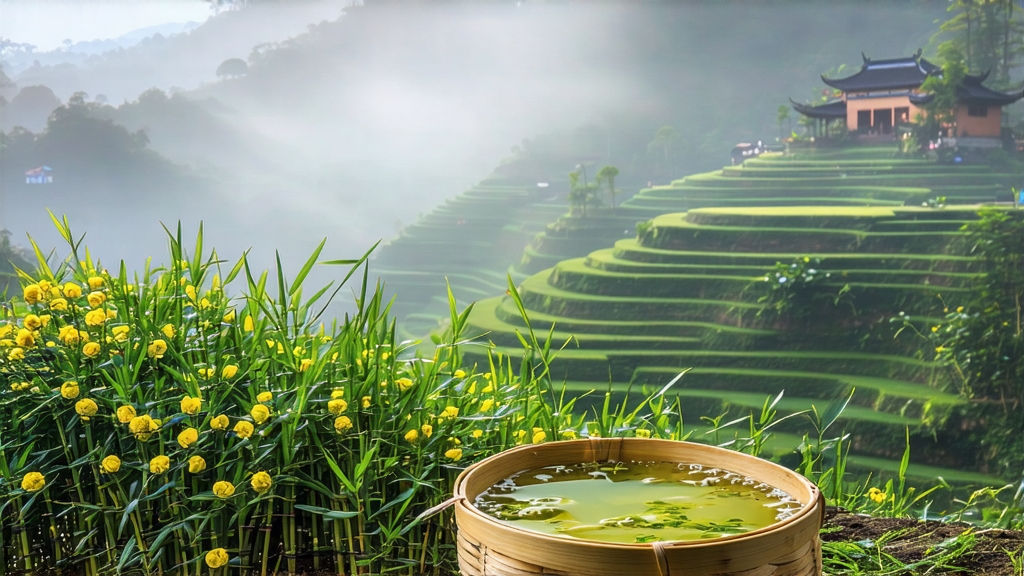
Mengding Huangya, literally “Yellow Bud from Mengding Mountain,” is the earliest recorded yellow tea in Chinese written history and the one most frequently mentioned in Tang and Song dynasty court diaries. Situated in Ya’an, Sichuan, Mengding Shan has been shrouded in perpetual cloud and drizzle for millennia; its altitude (1 200–1 450 m), mineral-rich sandstone soil, and 85 % average humidity create a natural “yellowing chamber” that farmers later learned to replicate indoors. The result is a tea that carries the brisk clarity of green tea yet finishes with the mellow, almost custard-like sweetness unique to the yellow category.
Historical scrolls credit the Daoist monk Wu Lizhen with planting the first seven tea bushes on Mengding’s summit in 53 BCE, an event still celebrated every April during the “Sacred Bud Festival.” By Tang times (618-907 CE) the buds were compressed into cakes and freighted to Chang’an as “immortal tea,” while the Song emperor Huizong (r. 1100-1126) declared it one of the five imperial tributes, banning civilian trade under penalty of cane. After the Ming dynasty banned compressed tea in 1391, Mengding Huangya was re-invented as a loose, gently yellowed leaf, a technique that nearly vanished during the wars of the 1940s and was revived only in 1958 when three surviving elders of the Gan-Ming monastery dictated the 12-step craft to county officials. Today fewer than 120 households are licensed to produce authentic Mengding Huangya, and the entire annual yield seldom exceeds 1 800 kg, making it rarer per ounce than silver.
The cultivar of choice is the local “Mengding small-leaf group,” a landrace that keeps its terminal bud furled for 42 days in spring, accumulating theanine and soluble sugars while catechins remain low. Picking occurs during the 13-day window when the bud reaches 18–22 mm but before the first scale unfurls; only the spear, no leaf, is snapped off with the thumbnail at dawn while the dew is still “insect-repellent cool.” A master picker can finish 600 g of fresh buds in four hours, the exact quantity needed for 100 g of finished tea.
Crafting Mengding Huangya is a race against enzymatic time. The buds are spread on bamboo trays for no more than 30 minutes to lose surface moisture, then wok-fired at 160 °C for 3.5 minutes in 250 g batches. The firing is “killing green” yet gentler than green-tea fixation; polyphenol oxidase is left partially viable, the prerequisite for yellowing. While still at 50 °C the buds are hand-rubbed along the grain for 20 seconds to break epidermal cells and release mucilage that will later act as a humectant. Next comes the signature “sealed yellowing”: 4 cm of buds are layered inside a cedar box lined with wet hemp cloth, the lid closed and weighted with 5 kg stones. For 48 hours the tea stews in its own residual heat and moisture at 35 °C and 78 % RH, turning from jade to pale gold as chlorophyll degrades into pheophytin and catechins dimerize into theaflavins. The process is repeated twice more with 6-hour air rests in between, a rhythm known as “three yellowings, two exposures.” Finally the buds are dried in three ascending temperatures (60 °C, 80 °C, 55 °C) on horse-hair screens until moisture falls to 5 %, then rested for 20 days so the last traces of grassy qi can sublimate.
The finished leaf resembles a miniature golden sword: straight, 25 mm long, downy, and with a visible “knee” where the bud once bent toward the sun. When tipped into a warmed gaiwan it clinks like porcelain, releasing a fragrance of fresh corn silk and steamed Japanese kabocha. Infused with 85 °C water in a 1:15 ratio, the buds stand upright for 30 seconds before slowly sinking—a dance called “golden rain.” The liquor is the color of chardonnay with a faint green rim, delivering aromas of lychee, water-chestnut, and warm cream. On the palate it opens with a brisk, snow-pea snap, then folds into custard, toasted sesame, and a cooling camphor note that lingers in the throat for minutes. The fourth steep, brewed at